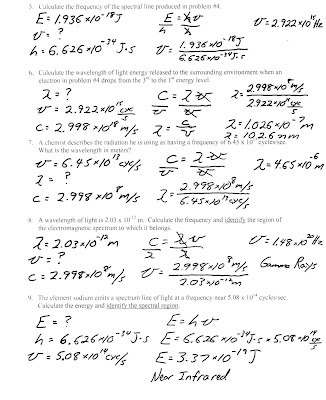
Monday, May 16, 2011
Studying for the Final Exam
Below are keys to work problems that have been completed in the last week and a half. Use them to study. Use your notes and the homework to study for the test. The test is 44 multiple choice questions.


Saturday, April 23, 2011
Bohr Model / Quantum Mechanics Test
Unfortunately, I will not have time to make up some practice questions for Monday's test over the material in Chapter 10. I have a plumbing emergency at my house and I do not have the time to spend on it. I will map out some things that you should know.
- Know about the "Light / Quantum Mechanics" packet. Know how to use all equations in the packet. All equations and constants will be supplied.
- Know the order of filling orbitals by using a periodic table. I will be supplying you with a periodic table for the test.
- Know the concept of penetration by an electron to lower principle energy levels and how this concept dictates the order on how the sub-levels and orbitals of different energy levels are filled.
- Know the shape of an "s" orbital (sphere) and a "p" orbital (dumb bell)
- Know the sub-levels that are in each principle energy level. 1st - s only; 2nd - s and p; 3rd - s, p, and d; 4th (and on) s, p, d, and f.
- Know how many orbitals are in each sub-level. You should be able to calculate how many electrons could be held in a particular principle energy. For example: How many electrons could be in the 4th principle energy level? The 4th principle energy level is the first time all of the sub-levels are present. Therefore; 1 orbital for the s, 3 orbitals for the p, 5 orbitals for the d, and 7 orbitals for the f will be a total of 16 orbitals. Each orbital can hold 2 electrons for a total of 32 electrons in the 4th principle energy level.
- Know how to write orbital diagrams, complete electron configurations, and noble gas electron configurations.
- Know the abnormalities for the electron configurations of chromium and copper.
- Know the difference between a ground state electron configuration and an excited state electron configuration.
- Know para-magnetism and di-magnetism based upon unpaired and paired electrons in an orbital.
The test is written and multiple choice. There are five written questions and 26 multiple choice questions.
Friday, April 15, 2011
Light / Bohr Model Packet Key
Thursday, April 14, 2011
Electromagnetic Chart
Wednesday, March 16, 2011
Answers For Concentration Packet #16 Through #21
Below are the anwers to the problems not done as examples in class from the Concentration / Molarity Packet. If you have questions on any of the problems, make sure to see me for help.
16.
b) 0.25 mol BaCl2 INXS // [BaCl2]=0.046 M
c) 1.26 mol NaCl (1.3 technically due to Sig. Figs) // [NaCl]=0.24 M
17.
b) 1.94 mol Al(NO3)3 INXS // [Al(NO3)3]=0.381 M
c) 5.91 mol KNO3 INXS // [KNO3]=1.16 M
19. [HNO3]=0.00141 M
21. [H2O2]=0.491 M
16.
b) 0.25 mol BaCl2 INXS // [BaCl2]=0.046 M
c) 1.26 mol NaCl (1.3 technically due to Sig. Figs) // [NaCl]=0.24 M
17.
b) 1.94 mol Al(NO3)3 INXS // [Al(NO3)3]=0.381 M
c) 5.91 mol KNO3 INXS // [KNO3]=1.16 M
19. [HNO3]=0.00141 M
21. [H2O2]=0.491 M
Tuesday, March 15, 2011
Answers For Concentration Packet Through #14
Below are the answers to the questions not done as examples in class from the Concentration / Molarity Packet. If you have questions on any of the problems, make sure to see me for help.
#2.--0.116 M KBr
#4.--1.00 mol NaOH
#6.--1.39 L
#8.--1.54 mol/L
#10.--Volume of 6.00 M NaOH needed is 0.583 L (or 583 mL). To prepare the 2.00 liters of 1.75 M NaOH solution, to the 0.583 liters of 6.00 M NaOH, 1.417 liters of water must be added to make a total volume of 2.00 liters.
#11.--1.38 M sucrose solution
#14.--3.70 M
#2.--0.116 M KBr
#4.--1.00 mol NaOH
#6.--1.39 L
#8.--1.54 mol/L
#10.--Volume of 6.00 M NaOH needed is 0.583 L (or 583 mL). To prepare the 2.00 liters of 1.75 M NaOH solution, to the 0.583 liters of 6.00 M NaOH, 1.417 liters of water must be added to make a total volume of 2.00 liters.
#11.--1.38 M sucrose solution
#14.--3.70 M
Monday, March 7, 2011
Gas Laws Test Study Reminder / Short Review
Below are four short review problems and the solutions to the problems. The review problems are optional. All material on all worksheets is fair game for the exam. The key for the Ideal Gas Law Worksheet can be found the Events Calendar of the class web-site. All calculator skills are fair game for the exam. The exam will consist of 22 multiple choice questions. Come and see me before the exam is you have any questions.


Thursday, February 10, 2011
Chapter 14 and 21 Test
Tomorrow (Friday, February 11th, 2011) will be the test over the stoichiometry unit (Chapter 9 in your book). I have posted the keys to ALL of the work packets used and quizzes taken in class on the Events Calendar of the class website. The work packets are under the date February 9th, 2011 and the quizzes are under the date February 10th, 2011. All of the material is good for review. Come and see me before the exam if you have any questions.
Thursday, January 27, 2011
Stoichiometry Packet #1 Answers
The key for Stoichiometry Packet #1 has been posted on the Events Calendar of the class web page. There will be a short quiz tomorrow over the material covered in the packet. The quiz will go in your homework category.
Subscribe to:
Posts (Atom)









